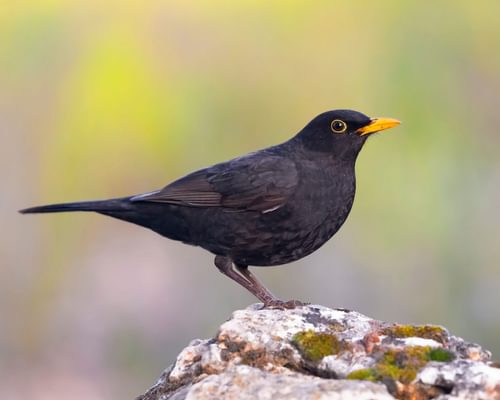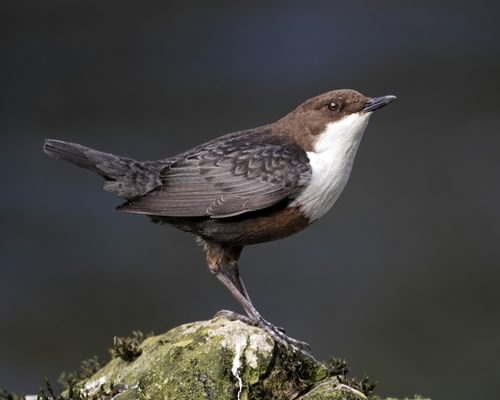Ring Ouzel
Turdus torquatus
Visual Identification
Appearance
The Ring Ouzel is a striking thrush with a distinctive white crescent on its breast. Males are predominantly black with silvery-grey wing edges, while females are browner with a less prominent breast band.
Females are similar to female Blackbirds but have a creamy crescent-shaped bib, smaller than the males. Both sexes have brownish-yellow bills and grey-brown legs.
Juveniles resemble females but have scaly patterns on their upperparts. During winter, both sexes develop pale fringes on their feathers, giving them a more mottled appearance.
From a distance, they can resemble Blackbirds, but Ring Ouzels are smaller and have longer tails.
Size
Length
23cm to 24cm
Wingspan
38cm to 42cm
Weight
90g to 138g
Habitat and Distribution
Habitats
Woodland
Garden
Wetland
Coastal
Urban
Farmland
Grassland
Desert
Tundra
Rainforest
Mountain
Savanna
Distribution
Ring Ouzels inhabit mountainous regions across Europe and Asia, favouring open, rocky areas with scattered vegetation. They breed in upland areas of Scandinavia, the UK, and central Europe.
During winter, they migrate to the Mediterranean region and North Africa. In the UK, they are summer visitors found in upland areas of Scotland, northern England, and Wales.
Dartmoor, north-west Wales, northern England and the north of Scotland offer the best chances of seeing a temporary resident Ring Ouzel. At the same time, along the east and southern coasts, migration passage sightings are recorded each spring and autumn.
Elevation Range
Up to 3,000 meters
Climate zones
Temperate, Subarctic
Distribution Map
This map gives you a rough idea of where you might spot a Ring Ouzel. The coloured areas show countries where these birds have been seen.
A few things to keep in mind:
- Birds might not be everywhere in the coloured areas, for example, they may be present around the coast of that country
- Where birds live can change with seasons and available food
- This map is quite simple - it doesn't show exact locations
We're working on making our maps even better! Soon, we hope to show you:
- More detailed maps for bigger countries, including state and region
- How birds move around during different seasons
Distribution by Region
Behaviour and Ecology
Bird Attributes
This feature is in beta. We'd love your feedback to improve it!
Share your thoughtsBird Attributes Explained
Our bird attributes system rates various aspects of a bird's capabilities on a scale of 0-100, based on data from field observations, scientific studies, and expert knowledge.
Attribute Categories:
- Agility: Manoeuvrability, speed, and grace in flight or movement.
- Strength: Physical power, often correlating with size and hunting abilities.
- Adaptability: Ability to thrive in various environments or changing conditions.
- Aggressiveness: Territorial behaviour and assertiveness, particularly during breeding seasons.
- Endurance: Stamina, often seen in migration patterns or foraging behaviours.
Understanding the Ratings:
- 0-20: Very Low
- 21-40: Low
- 41-60: Average
- 61-80: High
- 81-100: Very High
Remember, these attributes are relative to other bird species and don't necessarily indicate superiority.
Hover over the icon next to each attribute for more information.
Tap the icon next to each attribute for more information.
Agility
Reflects the bird's manoeuvrability, speed, and grace in flight or movement.
Ring Ouzels demonstrate high agility, capable of swift flight at speeds up to 32 km/h (around 20 mph) during migration. Their ability to navigate rocky, mountainous terrains and forage on the ground with quick movements further supports their agile nature.
Strength
Indicates the bird's physical power, often correlating with size and hunting abilities.
Whilst not exceptionally strong, Ring Ouzels possess moderate strength suitable for their size and lifestyle. They can carry nesting materials and food for their young, and their ability to survive in harsh upland environments suggests a reasonable level of physical robustness.
Adaptability
Represents the bird's ability to thrive in various environments or changing conditions.
Ring Ouzels show good adaptability, evidenced by their ability to thrive in various upland habitats across Europe and Asia. Their seasonal plumage changes and specialised gut bacteria for digesting berries during migration demonstrate adaptive traits.
Aggressiveness
Measures the bird's territorial behaviour and assertiveness, particularly during breeding seasons.
Generally shy and wary, Ring Ouzels are not particularly aggressive birds. However, they do exhibit some territorial behaviour during breeding season and will give alarm calls when disturbed, indicating a moderate level of assertiveness.
Endurance
Reflects the bird's stamina, often seen in migration patterns or foraging behaviours.
Ring Ouzels display impressive endurance, undertaking long-distance migrations between their breeding grounds in northern Europe and wintering areas in the Mediterranean and North Africa. Their ability to survive in harsh upland environments also suggests high endurance.
Diet
Ring Ouzels primarily feed on invertebrates, including earthworms, spiders, leatherjackets, beetles, and caterpillars. They also consume a variety of berries, especially during autumn migration and in winter. They often forage on the ground, running and pausing to search for prey.
During autumn migration, juniper berries form the most important element of a ring ouzel’s diet, and the availability of the fruit is a major influence over their migration routes and final destinations.
Small reptiles, amphibians, and small mammals may occasionally be caught on the ground and eaten.
Behaviour
Ring Ouzels are typically shy and wary birds. They often perch conspicuously on rocks or bushes, bobbing their tails and giving alarm calls when disturbed.
During migration, they may form small flocks but are generally solitary or found in pairs during the breeding season.
Vocalisation
The Ring Ouzel's song is a melancholic, fluty warble, often delivered from a prominent perch. It's similar to a Blackbird's song but more limited in range and variety.
Their alarm call is a sharp, repeated 'tac-tac-tac' or 'chack-chack', distinctive in their upland habitats.
Nesting & Breeding
Ring Ouzels form monogamous pairs during the breeding season, which typically begins in April. Males establish territories and attract females with their melodious songs.
Nests are built on or close to the ground, often in heather, rocky crevices or under overhanging banks. The cup-shaped nest is made of grass, moss, and mud. Females lay 3-5 pale greenish-blue eggs with reddish-brown spots.
Incubation lasts about 14 days and is primarily carried out by females. Both parents feed the chicks, which fledge after 12-14 days. Some pairs may produce two broods in a season.
Conservation and Status
Global Conservation Status
While listed as Least Concern globally, Ring Ouzels have experienced significant declines in parts of their range, particularly in the UK. Habitat loss due to changes in upland land management and climate change are key threats.
Conservation efforts focus on maintaining suitable breeding habitats.
Birdwatching Tips
- Look for Ring Ouzels in upland areas, particularly on rocky slopes with scattered vegetation.
- Listen for their distinctive 'tac-tac-tac' alarm call, which often reveals their presence.
- In the UK, search for them during spring and autumn migrations in coastal areas and inland hills.
- Be patient and move slowly, as they can be quite shy and quick to flee.
Additional Information
Quick Facts
Predators
Main predators include birds of prey such as Peregrine Falcons and Merlins, as well as foxes and stoats, which may raid nests for eggs and chicks.
Did You Know?
- Ring Ouzels can fly at speeds of up to 32 km/h (around 20 mph) during migration.
- They are known as 'Mountain Blackbirds' due to their preference for high-altitude habitats.
- Ring Ouzels have specialised gut bacteria that help them digest berries efficiently during migration.
FAQs
How to attract Ring Ouzels?
Ring ouzels are not especially fond of human company and seek relatively isolated, out-of-the-way nesting sites to raise their young. Feeding occurs on short grassland slopes and moorlands rich in heather and other thorny vegetation.
Ring ouzels prefer sites that offer plenty of shelter and undergrowth as cover when raising their young. They tend to favour undisturbed areas, and nesting sites used in previous years are abandoned if they experience disturbance or too much exposure to human presence.
Similar Birds
References
- 1 2
website: BirdLife International. 2019. Turdus torquatus (amended version of 2018 assessment). The IUCN Red List of Threatened Species 2019: e.T22708768A155629409.
View source - 3
report, 2015: EBCC
- 4
website, 2010: Fransson et al., EURING list of longevity records for European birds
View source
Share Your Feedback
We value your opinion! Let us know what you think about this bird page.

